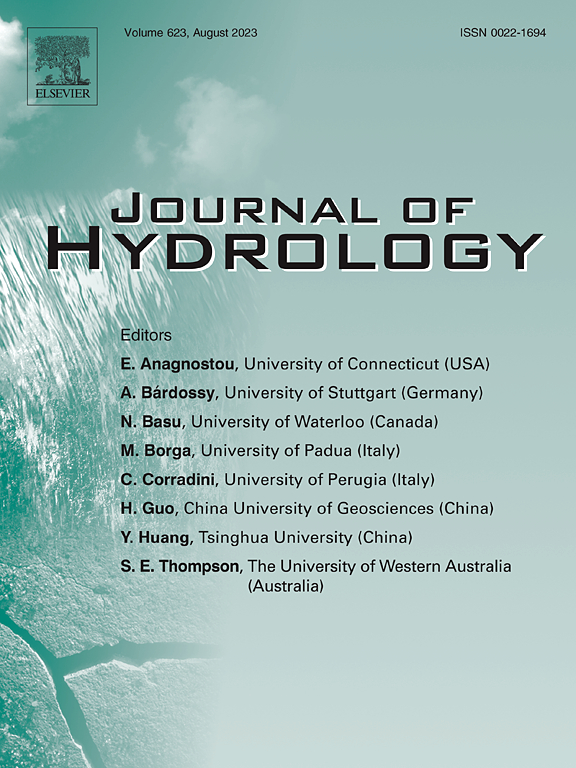流体密度对垂直河床通量和沉积物热物性估算的影响
IF 5.9
1区 地球科学
Q1 ENGINEERING, CIVIL
引用次数: 0
摘要
淡水盐碱化改变了河流中的流体密度,影响了地下流动、溶质和热输送。考虑流体密度的影响,利用热作为示踪剂量化河床垂直通量(VSFs)和河床沉积物有效热扩散系数的研究是有限的。本文提出了一个损失流河床中地下流动-溶质-热输运的耦合概念模型,并采用有限元法推导了数值解。为了研究流体密度对参数估计的影响,采用粒子群优化(PSO)和已有的解析解相结合的方法,基于温度-时间序列估算了不同盐浓度下河流水体的VSFs和有效热扩散系数。在流体密度效应的影响下,评估了VFLUX2方法的准确性和可靠性。结果表明:流体密度对水射流系数估算的影响大于对有效热扩散系数的影响,且流体密度对水射流系数的影响随深度的增加而增大。随着河流水密度的增加,使用传统的分析模型来量化VSF可能会导致对VSF的低估,特别是当观测深度大于0.2 m时。当使用VFLUX2方法估算流体密度变化下河床沉积物的有效热扩散系数时,当温度测量深度大于0.2 m时,VSFs也可能被严重低估。在下部(小于0.2 m),参数估计结果表明,由于计算误差和渗流时间短,密度效应没有出现。一旦河床内的流体密度稳定,即使存在比以前更高的密度,VFLUX2或传统分析模型估计的VSFs仍然是可靠的。这项研究为使用热作为示踪剂来量化受流体密度变化影响的VSFs提供了新的见解。本文章由计算机程序翻译,如有差异,请以英文原文为准。
Influence of fluid density on the estimation of vertical streambed fluxes and sediment thermal properties
Freshwater salinization alters the fluid density in the river and affects subsurface flow, solute and heat transport. Studies for quantifying vertical streambed fluxes (VSFs) and the effective thermal diffusivity of streambed sediments using heat as a tracer, considering the influence of fluid density, are limited. This study introduces a coupled conceptual model of subsurface flow-solute-heat transport within a streambed of losing streams, with the numerical solution derived using the finite element method. To investigate the impact of fluid density on parameter estimation, a combination of particle swarm optimization (PSO) and an existing analytical solution is employed to estimate VSFs and effective thermal diffusivity based on temperature–time series across varying salt concentrations in the river water. The accuracy and reliability of the VFLUX2 method are assessed under the influence of the fluid density effect. Results show that fluid density has a more significant influence on the estimation of VSFs than on the effective thermal diffusivity, and the impacts of fluid density on VSFs increase with increasing depth. As river water density increases, the use of traditional analytical models that quantify VSFs could result in an underestimation of VSF, especially when the observation depth is greater than 0.2 m. When using the VFLUX2 method to estimate effective thermal diffusivities of streambed sediments amidst fluid density variations, the VSFs may also be underestimated significantly when temperature measurements are taken at depths greater than 0.2 m. In the lower portion (less than 0.2 m), parameter estimation results indicated that the effect of density effects failed to appear due to the computational errors and short seepage times. Once the fluid density within the streambed stabilizes, even in the presence of higher density than before, the VSFs estimated by VFLUX2 or conventional analytical models remain reliable. This study provides new insights into the use of heat as a tracer to quantify VSFs when subject to fluid density variation.
求助全文
通过发布文献求助,成功后即可免费获取论文全文。
去求助
来源期刊

Journal of Hydrology
地学-地球科学综合
CiteScore
11.00
自引率
12.50%
发文量
1309
审稿时长
7.5 months
期刊介绍:
The Journal of Hydrology publishes original research papers and comprehensive reviews in all the subfields of the hydrological sciences including water based management and policy issues that impact on economics and society. These comprise, but are not limited to the physical, chemical, biogeochemical, stochastic and systems aspects of surface and groundwater hydrology, hydrometeorology and hydrogeology. Relevant topics incorporating the insights and methodologies of disciplines such as climatology, water resource systems, hydraulics, agrohydrology, geomorphology, soil science, instrumentation and remote sensing, civil and environmental engineering are included. Social science perspectives on hydrological problems such as resource and ecological economics, environmental sociology, psychology and behavioural science, management and policy analysis are also invited. Multi-and interdisciplinary analyses of hydrological problems are within scope. The science published in the Journal of Hydrology is relevant to catchment scales rather than exclusively to a local scale or site.
 求助内容:
求助内容: 应助结果提醒方式:
应助结果提醒方式:


